• GPX file
• Profile
• Logbook
• Where are we?
Photo album:
• Stewart Island
Recommended services:
Did you find our website useful?
THANK YOU!
Leg breakdown:
Date Activity Leg Distance (Km) Elev. Gain (m) Elev. Desc. (m) 16-Feb-19 Hiking Freshwater landing to Mason Bay 17.2 63 63 17-Feb-19 Hiking Mason Bay to pilot whales 17.6 39 38 18-Feb-19 Hiking Mason Bay to Freshwater landing 14.4 50 56
16-18 February, 2019: Stewart island
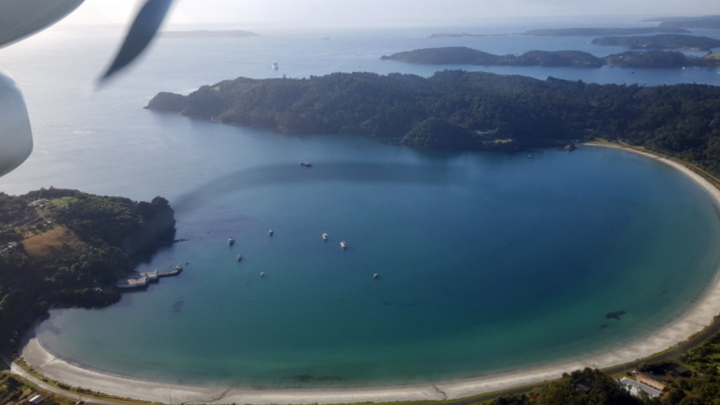
There are several reasons why seeing kiwis in the wild is easier on Stewart Island. First because there are many more, comparatively with other places, about 20,000 in the whole island. Second because they are not strictly nocturnal. It seems that due to the short summer nights, they do not have enough time to take turns incubating the egg and feeding. The third reason is that the species that lives in Stewart Island is bigger and should be more likely to spot them… In addition, we have firsthand information of a place where no matter what, we should spot one. One of the wardens of the Hump Ridge track shelters was responsible for the Mason Bay shelter on Stewart Island. According to him, the probability of seeing kiwis around Mason Bay is greater than 1. This privileged information convinces us that it is worth the effort and money to go to the island.
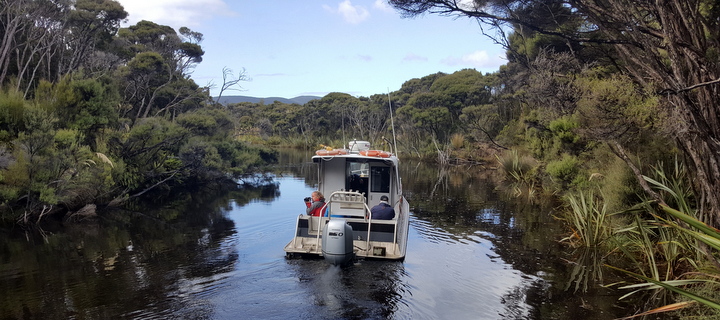
The flight from Invercargill to Oban, the only town on the island, lasts only 20 minutes. The plane is one of those tiny ones where the pilot does all the functions. The clouds between us and the island are loaded with rain. We can assure this because they create a weird rainbow below the plane, more than 180 degrees wide and with the bow upside down. The next trip leg to the kiwis is by motorboat that take us from Golden Bay to Freshwater Landing, going up the Freshwater River a few kilometers. We wanted to do this leg by kayak, but the guy who rented them, after looking at the weather forecast advised us not to do it because of the strong winds that were forecast. The forecast was correct. The boat trip is choppy up to the river mouth. In addition, the waves generated within the river would be very unpleasant for a kayak. The river is wide enough for a couple of boats, but no more. In addition, it is only navigable during high tide.
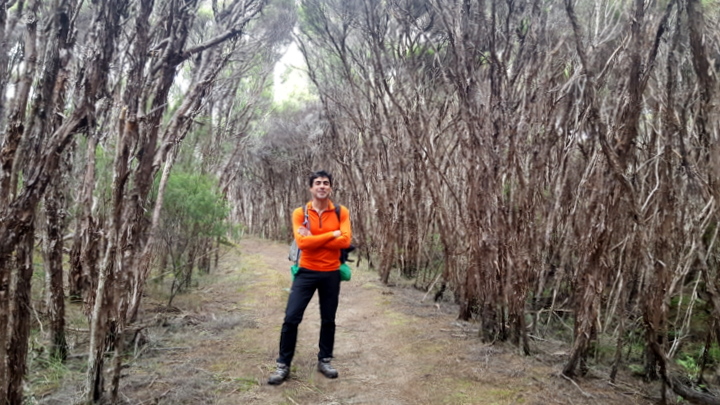
Once we disembark at Freshwater Landing, we start the hike to the Mason Bay hut, on the coast opposite the mouth of the river that we have just sailed upstream. The route is totally flat and thanks to the wooden boardwalks and a few jumps and pirouettes, we managed to keep our feet quite dry while we cross the wetland that covers much of this area of the island. The landscape is not spectacular. Much of the hike goes through tunnels of tea three. When there is visibility outside the forest, it is because you are in the middle of the wetland surrounded by reeds and other aquatic plants. With our eyes fixed on the giant dunes on the horizon, after 14 km we reach the hut. The beach is still 1.5 km from the hut but we cannot resist to get closer to see how rough the sea is due to the blowing wind. The view from the top of the dune is intimidating. The dark color of the water and the succession of breaking waves from far away from the shore, makes us wonder once again why would anyone want to live here.
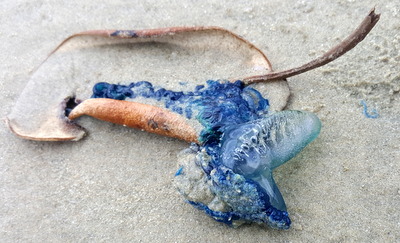 We go out at dusk to see kiwis and we have no luck. We go out at dawn to see kiwis and we have no luck either. At least the pilot whales that stranded a few weeks ago on the south end of the bay are still there. Fairly rotten, but it is something that one cannot see very often, so we go to see them. The wind is constant all day. On the way to the whales it rains considerably and we are soaked from the waist down, because we haven’t brought the gore-tex pants. But by the time we get close to the whales, we are already dry thanks to the wind that does not stop. During the last kilometer we have to cover our nose to avoid the putrid smell that the wind brings us. The first group is composed of more than 70 whales. They are scattered on the tide line, half buried in the sand. Most still preserve the skin, in different degrees of deterioration, but on others the rib cage is already visible. The biggest ones measure between 4 and 5 meters. A kilometer ahead there is a second group, which we do not approach to. The pilot is one of the species of whales with teeth. There are several theories that try to explain why whales strand in groups. In the case of the pilot whales, one of the theories says that when one of the members of the pod is sick and strands, the rest also strands because of the strong bond between the members of the pod. It does not seem a very logical explanation, because there will always be a member in any pod that will die sooner or later. Another theory indicates that when pilots are in very shallow water, they cannot use their echolocation system and get confused. Whatever the reason and for more natural that it can be, it is very sad to see this pod decomposing on the beach.
We go out at dusk to see kiwis and we have no luck. We go out at dawn to see kiwis and we have no luck either. At least the pilot whales that stranded a few weeks ago on the south end of the bay are still there. Fairly rotten, but it is something that one cannot see very often, so we go to see them. The wind is constant all day. On the way to the whales it rains considerably and we are soaked from the waist down, because we haven’t brought the gore-tex pants. But by the time we get close to the whales, we are already dry thanks to the wind that does not stop. During the last kilometer we have to cover our nose to avoid the putrid smell that the wind brings us. The first group is composed of more than 70 whales. They are scattered on the tide line, half buried in the sand. Most still preserve the skin, in different degrees of deterioration, but on others the rib cage is already visible. The biggest ones measure between 4 and 5 meters. A kilometer ahead there is a second group, which we do not approach to. The pilot is one of the species of whales with teeth. There are several theories that try to explain why whales strand in groups. In the case of the pilot whales, one of the theories says that when one of the members of the pod is sick and strands, the rest also strands because of the strong bond between the members of the pod. It does not seem a very logical explanation, because there will always be a member in any pod that will die sooner or later. Another theory indicates that when pilots are in very shallow water, they cannot use their echolocation system and get confused. Whatever the reason and for more natural that it can be, it is very sad to see this pod decomposing on the beach.
We go out at dusk to see kiwis and we have no luck. We go out at dawn to see kiwis on the way back to Freshwater Landing and we have no luck either. We are starting to believe that the kiwi is extinct and that the sightings that other tourists report are chickens with false beaks that tourism companies release at night and pick up in the morning. Anyhow, at night you only see a fat bird with two legs. Back on the motorboat to Oban, we are followed by albatrosses. The skipper stops the motorboat and the albatrosses fly low over us thinking that we are a fishing boat. We can appreciate its enormous wingspan, up to 2.8 meters. They are like giant seagulls. Before returning to Oban we stop at Ulva, an island converted into a bird sanctuary. In a couple of hours we spot a lot of different species: New Zealand pigeon, saddleback, kaka, weka, fantails, tomtit, etc. It seems that we are inside an aviary. Bird calls are heard everywhere.
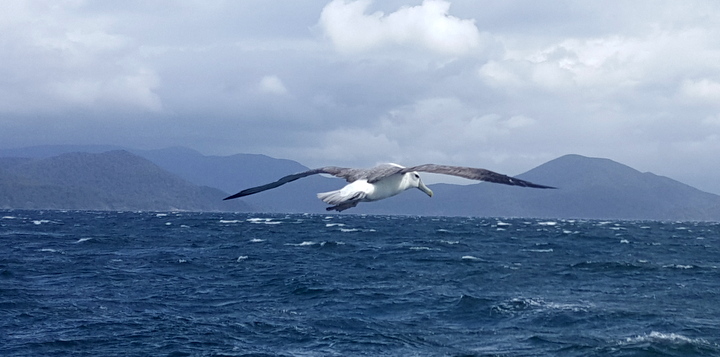
During these days we have shared several moments with a group of very nice kiwis (people, not birds). We have dinner with them at the Oban pub while we wait for the sunset to see the blue penguins returning from their fishing day and our last opportunity to spot kiwis (birds, not people). We have become friends with those humans. We still hate the birds, though.
© 2018 Explore Pangea. All Rights Reserved. Website Terms of Use.